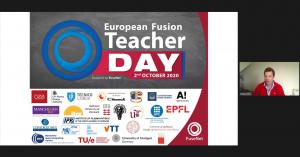Fusion world
Teaching teachers about fusion
20 Oct 2020
-
Sabina Griffith
The possibility to visit three fusion facilities, all in one afternoon. Welcome to the new virtual world! More than 300 science teachers recently seized the opportunity and joined the first European Fusion Teacher Day, organized by the European Fusion Education Network FuseNet.
At the start of the afternoon event on 2 October 2020, Roddy Vann, FuseNet Chairman and Professor at York University (UK), welcomed the more than 300 participants.
Twenty-four institutions and universities from 16 countries across Europe acted as hosts to the first Fusion Teacher Day event (see the full list). Teachers could sign up to 17 parallel sessions given in 16 languages, and they did—eager to learn more about the current state of research and to directly exchange with the experts on topics such as possible environmental risks, the economic viability of fusion, and how students can enter the field. All questions were answered online by an international team of scientists and engineers.
"The success of fusion requires the next generation of scientists, policymakers, financiers and elected officials, among others, to have a grasp of the principles of fusion energy and to be able to debate the issues in an informed way," explains Roddy Vann, FuseNet Chairman and Professor at York University (UK). "Teachers, particularly in secondary schools, are critical in encouraging young people that they have a role to play. It was our great pleasure to host such a large number of educators at this inaugural teacher's day."
After the sessions, the registrants were taken by livestream to the sites of three fusion experiments in Europe—the Golem tokamak operated by the Czech Technical University of Prague, where they witnessed a plasma discharge; the JET tokamak (UK), for a virtual tour and a stop in the control room; and finally a live feed from the ITER Assembly Hall.
Educational material prepared for the event will be made freely available on the FuseNet website shortly. See more here.


